
The Importance of Volunteer Pulse Surveys
While volunteer pulse surveys are relatively new, in the corporate world these kinds of surveys are a common tool when it comes to employee engagement.
And, while they have not really been used very much in the volunteer space they can be particularly valuable, especially during the current pandemic.
With many teams working remotely, pulse surveys can help us to check-in with our volunteers and understand where they’re at in relation to your efforts, and how they are doing.
Taking Action from Pulse Surveys
Anytime you develop any survey, you need to first think about what you want from the end results.
What do we want from a pulse survey? Usually, it’s fueled by the need to get quick actionable information.
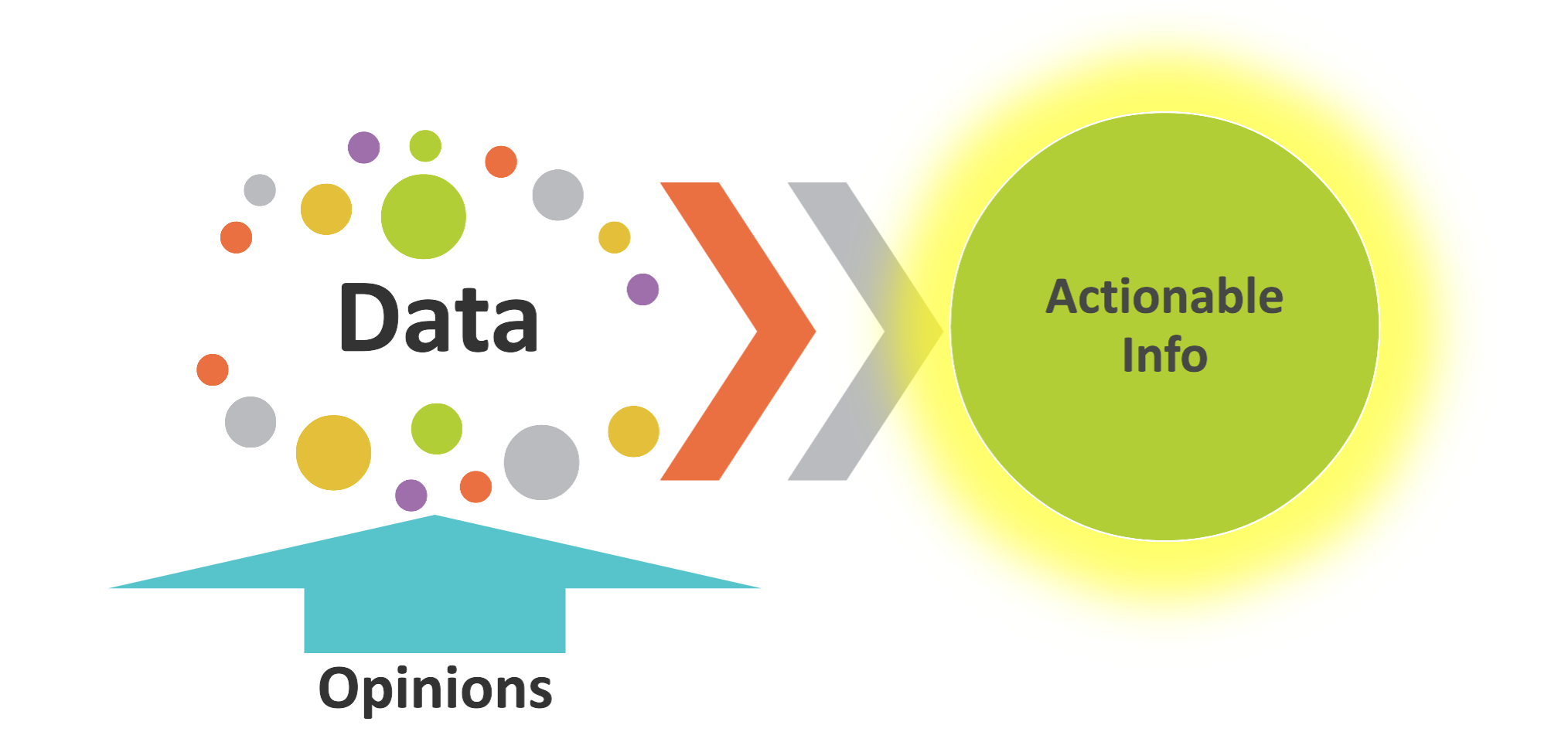
While they can be used to connect with volunteers, surveys shouldn’t be used simply because you want to stay connected to your volunteers. It must have a higher purpose. You are requesting feedback because you intend to take action of some kind based on the responses you receive.
If you’re asking your audience for feedback and you do nothing with the information, it can damage your relationship. This is because you’ve now set up the expectation that you’re going to follow through.
You need to do more than pay lip service to getting feedback. ‘Nuff said.
Because you will need to take some sort of action based on pulse survey results, make sure that you have a little bit of time, energy, and resources to make that happen.
Part of that action might be reporting to your leadership where your volunteers are at, but even using surveys for that purpose will require some type of response on your part directed at volunteers. They will want to know what you plan to do. So just keep that in mind.
Types of Volunteer Surveys: All Can Be Used As Volunteer Pulse Surveys
There are four different main types of surveys. Different types serve different purposes and gather different kinds of data.
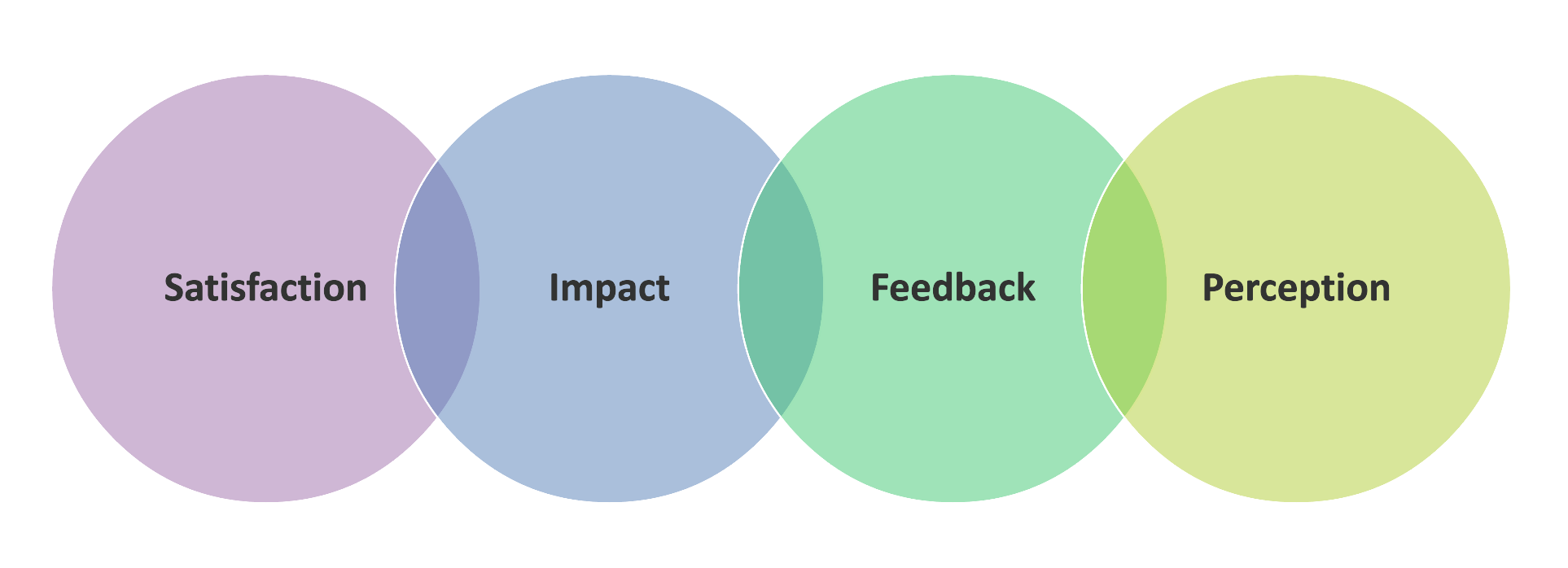
Satisfaction Surveys
Satisfaction surveys help you assess how much or how little people are satisfied with their experience. Annual volunteer satisfaction surveys are the most common, but you might also send surveys at shorter intervals, for example, 90 days after the volunteer has been on board for three months.
Once you collect the data, you can begin to figure out what management interventions you might take to increase satisfaction and address systemic issues. Research shows that there is a high correlation between volunteer satisfaction and volunteer retention, so surveys like these can help you predict future outcomes.
Impact Surveys
Impact surveys are different than satisfaction surveys in some important ways. Both satisfaction surveys and impact surveys can reflect volunteer perceptions. Data collected from impact surveys can give clues as to whether volunteers have the perception that an impact has been made through their =service.
It doesn’t necessarily prove that impact has occurred, but there’s a perception that it’s there. The only way to really track impact is to study the results that occur due to volunteer experiences or volunteer service.
But impact surveys are a nice way to see if volunteers believe they’re having an impact. Research shows that feelings of self-efficacy or empowerment can lead to higher volunteer retention rates. So, if people perceive that they’re not making a difference, then you can pinpoint that problem and try to address that as a manager.
Feedback Surveys
Feedback surveys offer the opportunity for volunteers to give you specific feedback about ways to make the end-user experience better for volunteers or the people they are serving.
Feedback surveys are more about, “What are the specific suggestions you have for us” than general satisfaction or impact. They can focus on specific steps in the volunteer lifecycle, for example after onboarding or training. The best times to use these are when you suspect a process or part of the volunteer journey could be improved, but you’re not sure how. Or you want to double-check that few complaints do (or do not) represent a widespread systemic issue.
Perception Surveys
While any of the surveys typed listed above might also be categorized as a perception survey, there is a particular use case that can be helpful as well, Perception surveys can help you ascertain frame of mind, reaction, or assessment of a particular situation. For example, assessments of volunteer-staff teamwork might be considered a perception survey.
When it comes to perception surveys related to the volunteer effort, there are different audiences for these surveys — coworkers, executive leadership, boards, volunteers, client or service beneficiaries, community partners, etc. Through these surveys, you can gather helpful information about their views on the volunteer effort or the state of the working relationships within the volunteer team or with others.
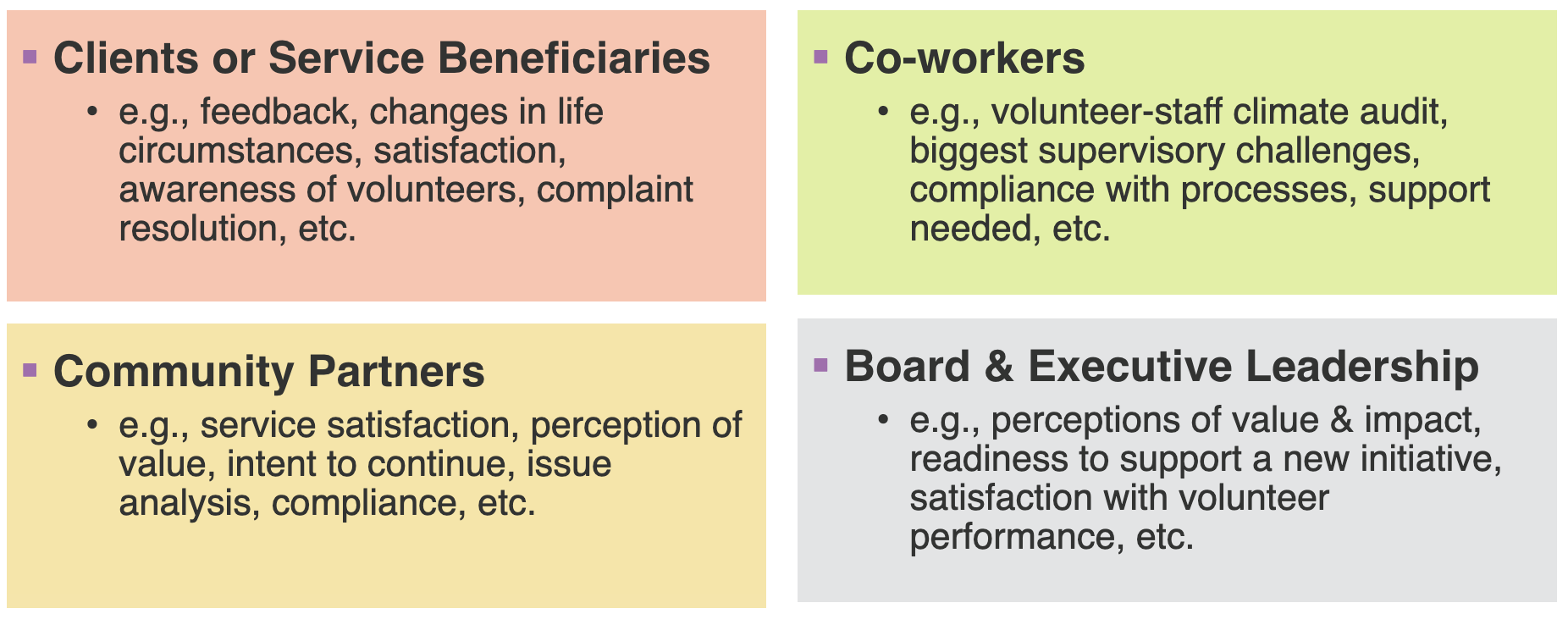
Everybody has a different view of reality. All of us have different brains. So, we’re all-seeing reality a little bit differently. So, it’s nice to see all those different perspectives.
Satisfaction vs Impact Surveys for Volunteers
With a satisfaction survey, you may be asking, “Are volunteer expectations met or exceeded?” Is their experience, the application process, a training course, and event they took part in on par with the expectations you set. The questions in your surveys can also be highly focused on a specific experience. They need not be overly general.
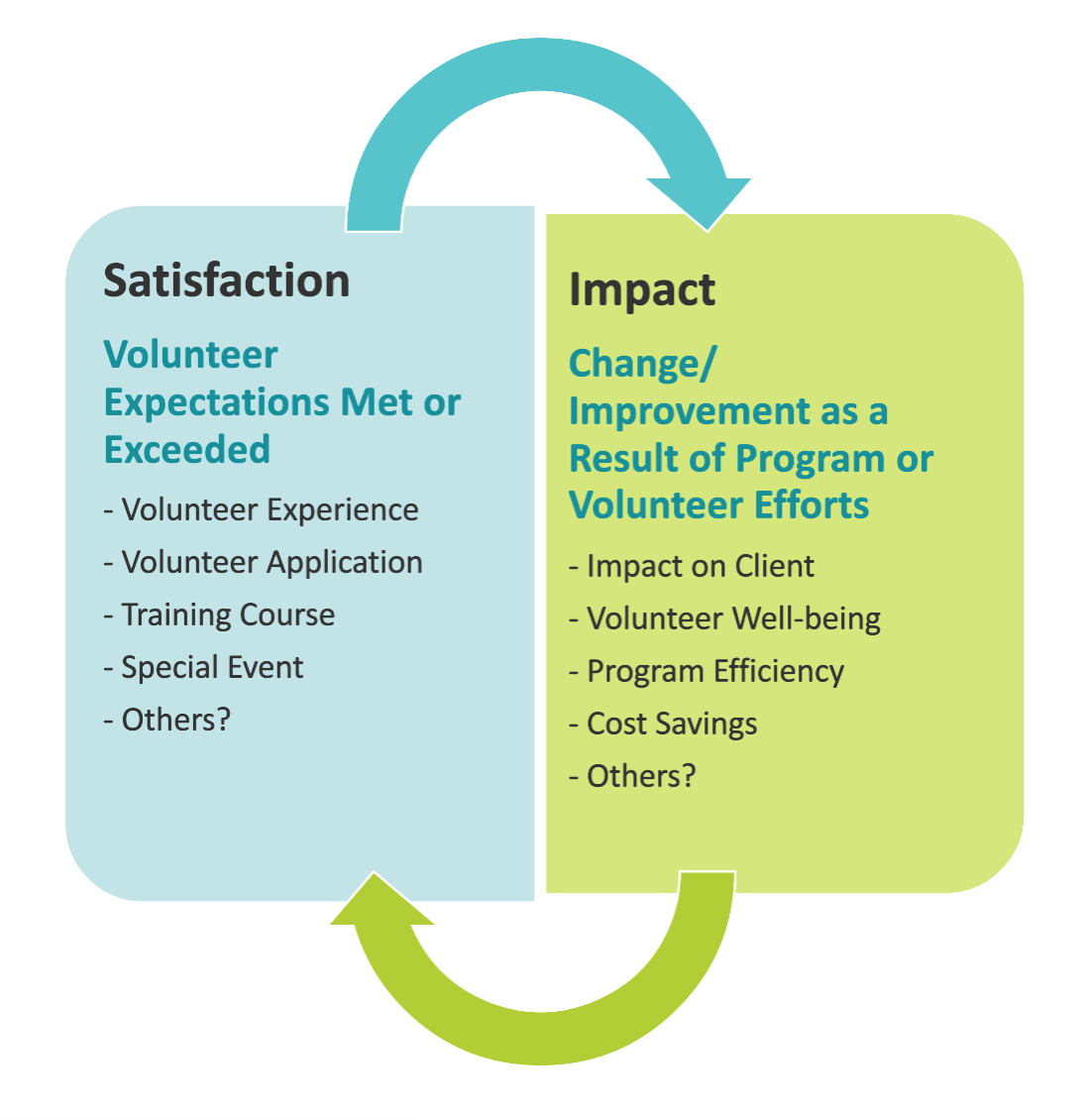
In fact, the more specific your questions, the more likely your impact surveys will accurately inform a change and create an improvement as a result.
Impact surveys might also ask questions about volunteers’ wellbeing. For example, they might ask respondents to rate whether volunteering itself has had an impact on them personally. This could be considered a program impact.
Satisfaction and impact surveys are slightly different. Make sure you understand which goals you hope to track so that you can choose the proper survey type.
Volunteer Pulse Surveys
Volunteer pulse surveys are a little bit different than regular volunteer surveys because they are sent at least monthly, even every two weeks. They often ask the same questions each time, to better track changes and trends in perception and experience. For example, they might track how ready volunteers are to return to onsite work during COVID.
Pulse surveys also tend to be a lot shorter. They are more like a poll than a more traditional survey.. If you are sending out long surveys every two weeks, your volunteers will get burned out. On the other hand, short pulse surveys a short are easy to respond to and can even be fun.
To ensure robust participation, let volunteers know ahead of time that you will be doing pulse checks on your volunteer team.
Why Pulse Surveys
There are several ways pulse surveys can help you with your volunteer strategy. They can help you …
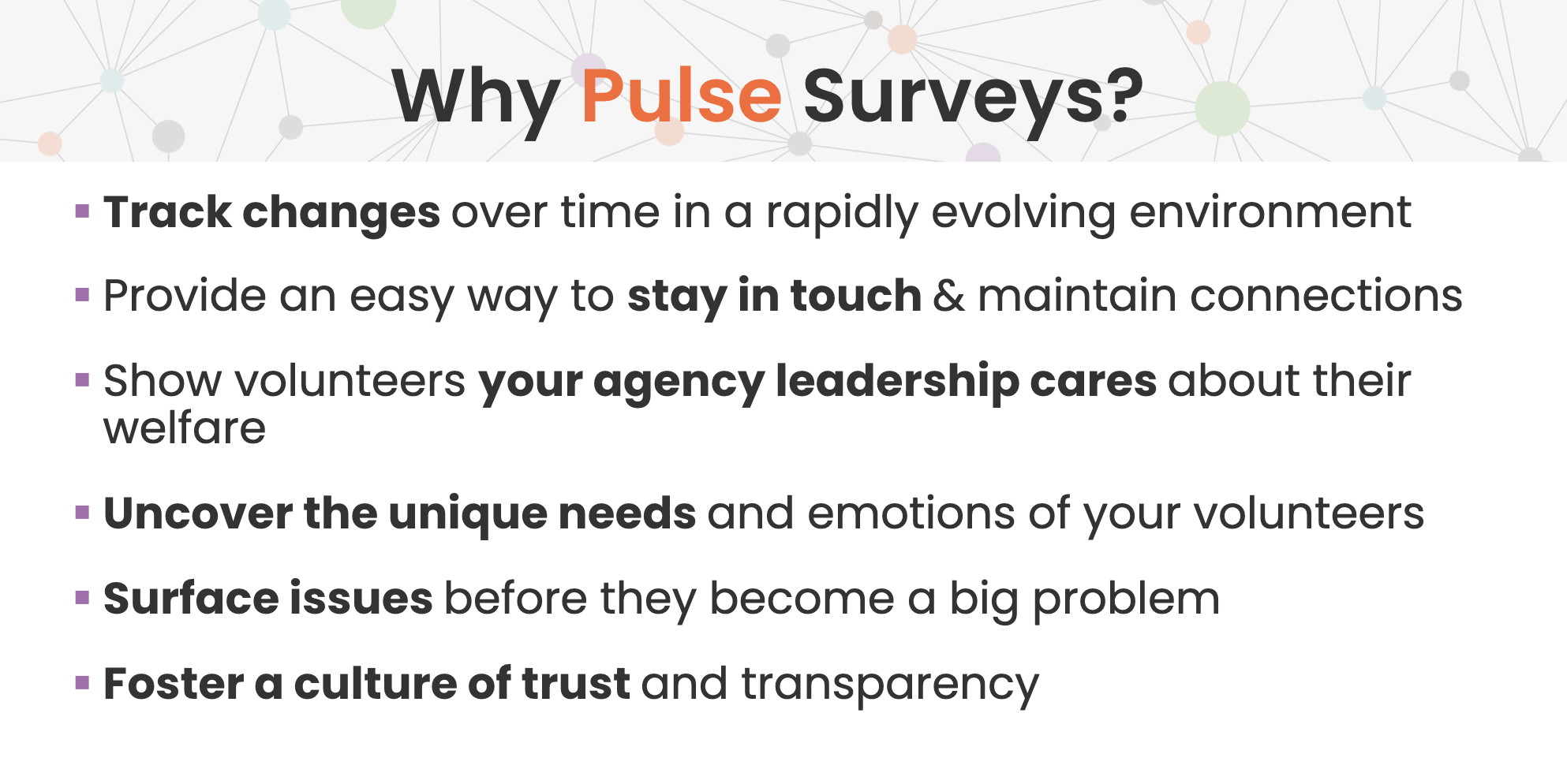
Track Changes
The nice thing about pulse check surveys is they can track changes, especially in a rapidly evolving environment. And I think we can all agree that our COVID environment right now is rapidly evolving. You know, things change day-to-day. In terms of whether we’re going to go back to work. When we’re going to go back to work. If we’re not at work, how safe or unsafe it is, whether people are using social distancing or masks, how many people can gather in a place together.
In a rapidly changing environment, pulse checks can help you have hard data to work from.
Stay In-Touch
Pulse surveys can also provide an easy way to stay in touch and keep communications with your volunteers. These surveys send a message to your volunteers that you really care about them and value them as part of your organization.
That said, pulse check surveys should not be undertaken simply for that particular goal and none other. There are many other, easier ways, to maintain connections. For example, you might set up a private Facebook group or send out broadcast emails There are many other ways to keep that connection, but it can also be a helpful byproduct of this type of survey.
Show Agency Leadership Cares
In addition, when combined with messaging from your executive, pulse surveys can prove to volunteers that your agency’s leadership cares about their welfare, not just you.
Depending on who the survey comes from – if it’s emailed out, if it comes from your executive director’s email address or your board chair – volunteers see that their feedback matters at the highest levels of the organization, What’s more, they may be more likely to open emails that deliver these surveys when they are from a person at the top of the hierarchy because it’s from somebody who’s perceived as important in everybody’s eyes.
Uncover Needs & Emotions
If you ask the right questions in your pulse surveys, the unique needs and emotions of your volunteers will reveal themselves.
What are your volunteers feeling at this moment? And you could, if you ask the same question, you could track that over time and see if people are starting to feel better, or if they’re starting to feel worse. With pulse surveys, you are able to track a trend and then surface issues before they become a larger problem for you.
Get Ahead of “Hidden” Issues
If there’s an area where you suspect there might be an issue, then you might add an open-ended question to your survey, such as, “Are there any challenges you’re experiencing that we need to know about?” After that, you can start to name and deal with those issues before they become something larger and harder to deal with.
Gain Trust
Pulse surveys can also foster a culture of trust and transparency.
But only if you are ready and willing to both share the results in a transparent way, and also report back what you’re going to do about what you learn.
Tune-In with Volunteer Pulse Surveys
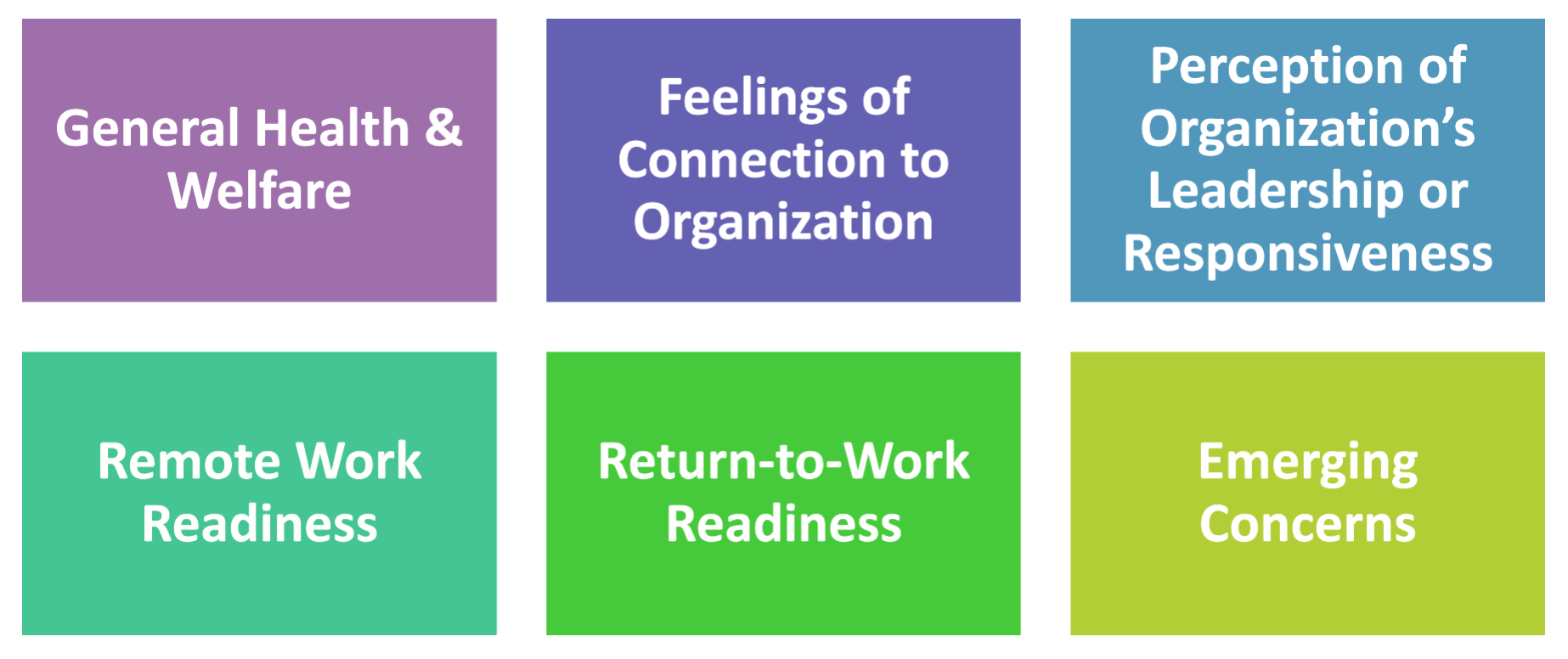
There are several topic areas you might cover in your pulse survey. One is general health and welfare. Just how are your volunteers doing right now? You know, if your volunteers are starting to feel down, if they live alone, if they’re in a vulnerable population, any of those things that make you concerned about the people that are supporting your organization, then you can check via, have a pulse survey.
You can also check people’s feelings of connection to your organization, or are they starting to lose interest, or are they feeling even more connected and supportive of you? You can figure that out through pulse surveys, you can cheat. You can even check the perception of your organization’s leadership or responsiveness to volunteers.
In addition, because leadership is so important during COVID-19, it is vital that we know what our volunteers think about how our organizations are led. If the volunteers don’t believe or trust in our leadership, they are not going to give much of their time and time and talent. This theme might also be explored through a pulse survey.
Furthermore, it is important for your volunteers to continue to trust you through this pandemic. You might also use pulse -surveys to check for remote work readiness. Are volunteers interested in, are they equipped to, are they ready to, are they comfortable with working remotely? You can ask those kinds of questions in your volunteer survey.
If you’re wondering about what your volunteers are thinking, don’t wonder… ask! That way can build a better understanding instead of guessing and make more informed management decisions.
Start with the End in Mind
If you’re going to do pulse check surveys, start with the end in mind.
What are your goals? What would you want to see in a final report or later reports from each pulse check survey and then maybe a final report of your pulse check surveys?
What are the existing volunteer issues that you already know about and want to know more about? Is it just a group of volunteers you’re interested in learning more about?
These pulse check surveys don’t necessarily have distributed to all volunteers either. You can track your volunteer team leaders or volunteers who work in a particular department.
You make that decision. What are going to be the most interesting and important results you’re going to want to report out and who’s going to need to hear these results and how can you best share them with everyone, including volunteers.
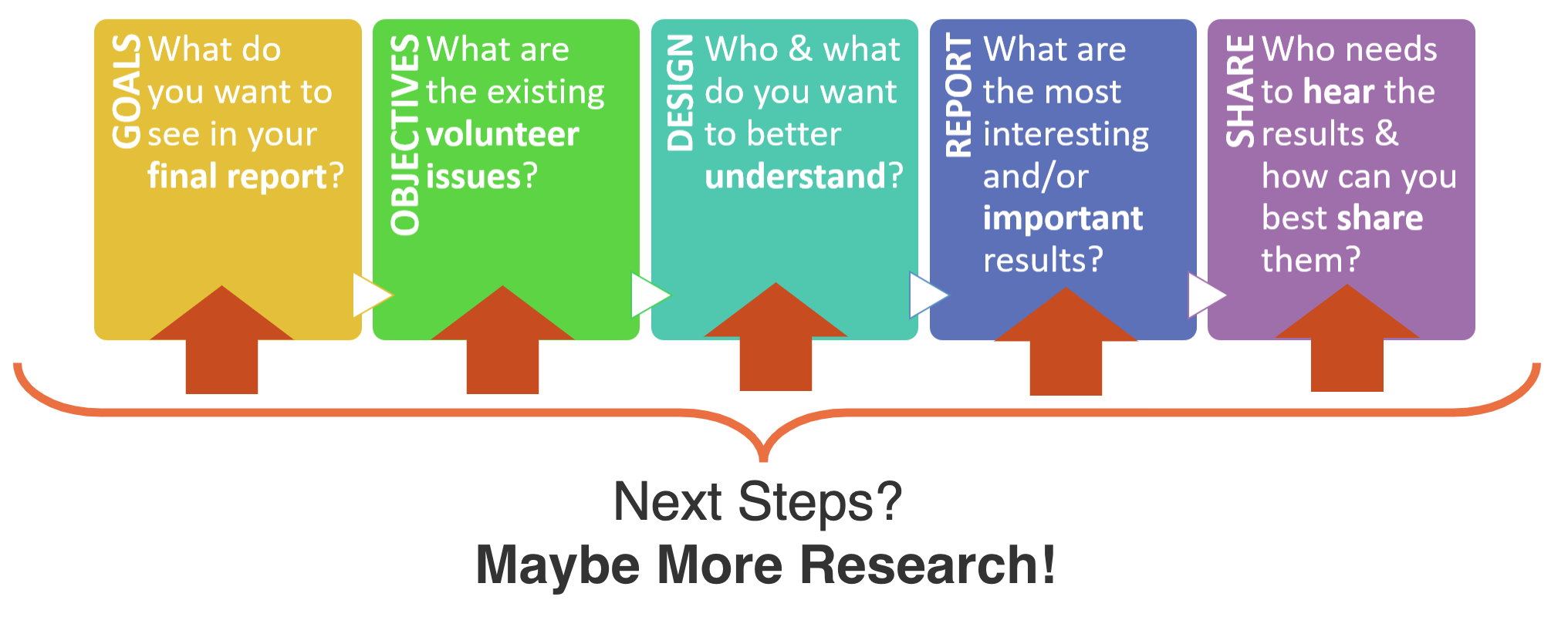
When you consider using surveys, keep in mind your different goals, your aims, how you’re going to design that survey, what you’re going to report out, and what you’re going to share, you may find that you need to do more research.
But be prepared to ask more questions. Research often brings up more questions than it answers. You may end up doing more research. That’s the beauty of pulse check surveys. In the next survey around you can ask another question.
When you’re trying to understand a group that is in flux in organizational culture or a community of people or workers, whether paid on paid, a pulse check survey is a really good way to keep your finger on the pulse of the climate as it changes.
Speaking of Surveys … Have You Seen Our VMPR Survey Yet?
Every year we conduct a state-of-the-industry study on volunteer administration. In fact, it is the largest crowdsourcing of this type of data in the entire world.
Over 6,000 leaders of volunteers like you from all over the world have participated over the last six years.
Our 2021 Volunteer Management Progress Report Survey will explore the effects COVID-19 has had on our industry.




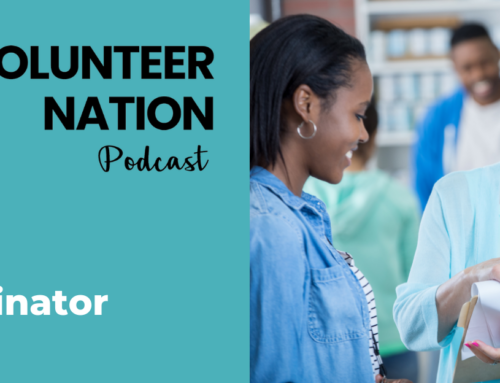

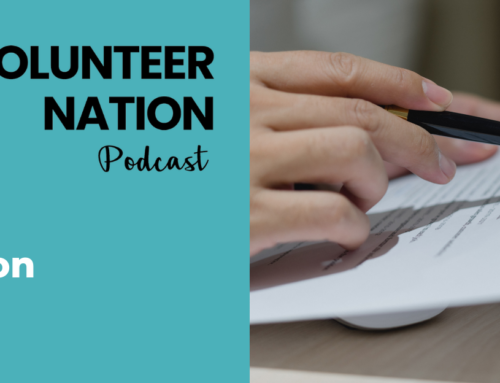
Leave A Comment